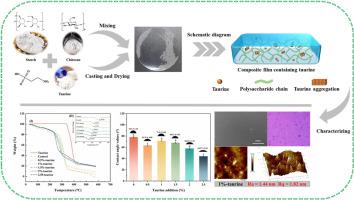壳聚糖/预胶化蜡质玉米淀粉复合可食用牛磺酸口腔崩解膜
IF 11
1区 农林科学
Q1 CHEMISTRY, APPLIED
引用次数: 0
摘要
本研究制备了添加牛磺酸的壳聚糖/过胶化蜡质玉米淀粉复合食用口腔崩解膜(ODFs),并对其形态、释放行为和储存稳定性进行了研究。X射线衍射、ATR-傅立叶变换红外光谱和显微镜研究结果表明,牛磺酸可以均匀地分散在薄膜基质中。牛磺酸的最佳添加量为 1.0%(重量比)。牛磺酸的加入改善了复合薄膜的表观形态、机械性能和持水能力,同时略微增加了薄膜厚度、崩解时间和接触角。此外,牛磺酸在薄膜中表现出快速释放的特性。Ritger-Peppas 模型的拟合结果表明,牛磺酸在复合薄膜中的释放机制主要是费克扩散,骨架侵蚀较小。作为一种递送载体,复合薄膜对牛磺酸的保存有积极作用,在贮藏期间牛磺酸的保留率提高了 8.34% ± 1.48%。该研究证实了开发牛磺酸 ODF 载体的可行性,并为功能性包装材料的开发提供了依据。本文章由计算机程序翻译,如有差异,请以英文原文为准。

Chitosan/pre-gelatinized waxy corn starch composite edible orally disintegrating film for taurine delivery
In this study, chitosan/per-gelatinized waxy corn starch composite edible orally disintegrating films (ODFs) incorporated with taurine were prepared and the morphology, release behavior and storage stability of the ODFs were investigated. The XRD, ATR-FTIR and microscopic investigation results revealed that taurine could be uniformly dispersed in the film matrix. The optimal level of taurine addition was 1.0% (w/w). The incorporation of taurine improved the apparent morphology, mechanical properties and water holding capacity while slightly increased the film thickness, disintegration time and contact angle of the composite films. In addition, taurine exhibited a rapid release behavior in the films. The fitted results of the Ritger-Peppas model indicated that the release mechanism of taurine in the composite films was mainly Fickian diffusion with minor skeleton erosion. As a delivery carrier, the composite film had a positive effect on the preservation of taurine, increasing the retention of taurine by 8.34% ± 1.48% during storage. The study confirmed the feasibility for the development of taurine ODF carriers and provided a basis for the development of functional packaging materials.
求助全文
通过发布文献求助,成功后即可免费获取论文全文。
去求助
来源期刊

Food Hydrocolloids
工程技术-食品科技
CiteScore
19.90
自引率
14.00%
发文量
871
审稿时长
37 days
期刊介绍:
Food Hydrocolloids publishes original and innovative research focused on the characterization, functional properties, and applications of hydrocolloid materials used in food products. These hydrocolloids, defined as polysaccharides and proteins of commercial importance, are added to control aspects such as texture, stability, rheology, and sensory properties. The research's primary emphasis should be on the hydrocolloids themselves, with thorough descriptions of their source, nature, and physicochemical characteristics. Manuscripts are expected to clearly outline specific aims and objectives, include a fundamental discussion of research findings at the molecular level, and address the significance of the results. Studies on hydrocolloids in complex formulations should concentrate on their overall properties and mechanisms of action, while simple formulation development studies may not be considered for publication.
The main areas of interest are:
-Chemical and physicochemical characterisation
Thermal properties including glass transitions and conformational changes-
Rheological properties including viscosity, viscoelastic properties and gelation behaviour-
The influence on organoleptic properties-
Interfacial properties including stabilisation of dispersions, emulsions and foams-
Film forming properties with application to edible films and active packaging-
Encapsulation and controlled release of active compounds-
The influence on health including their role as dietary fibre-
Manipulation of hydrocolloid structure and functionality through chemical, biochemical and physical processes-
New hydrocolloids and hydrocolloid sources of commercial potential.
The Journal also publishes Review articles that provide an overview of the latest developments in topics of specific interest to researchers in this field of activity.
 求助内容:
求助内容: 应助结果提醒方式:
应助结果提醒方式:


